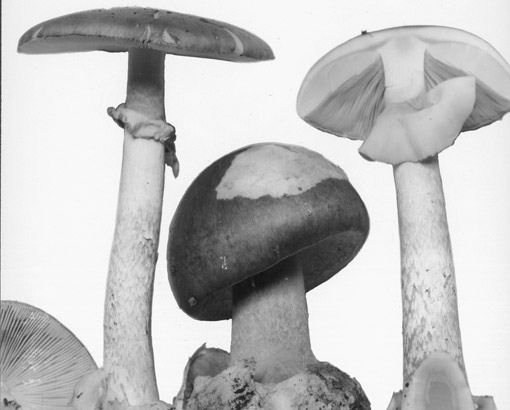Amanita phalloides
CUP-A-021145
Here's the most deadly mushroom in the world: the Death Cap. Atkinson wanted to understand how it differed from American species to which the name A. phalloides had been applied. He took this photo in France.
Mycology was fully developed in Europe long before it took off in North America. In the early days here (even now!), the names of European mushrooms were often used for similar-looking American species.
Atkinson recognized this problem. He made several trips to Europe to study living European mushrooms. In the course of doing so he also helped shape the future of fungal nomenclature at the 1905 Botanical Congress. He kept journals of his travels, two of which you can now read online.
The true Amanita phalloides did not occur in North America during Atkinson's life. It was later accidentally introduced, and now populations have become established.
Would you like to see what this same specimen looks like today?

Atkinson visited the Royal Herbarium at Kew Gardens on Sept. 18 1903. He wanted to look at type specimens of some American mushrooms.
"I began with the Amanitas. He [Massee] said in reference to the privilege of examining types with the microscope that the Director had recently passed a very rigid rule that the types could no longer be cut for examination. He referred to Burt's and Murrill's work on the types and said that in some cases the types were disappearing by this process, and they had found it necessary to establish this rule. He said he would speak again to the Director about it, but he was sure there could be no change. I said I did not know how one could ever know what the characters of the types were... In fact Mr. Massee thinks microscopic characters of little or no value in such plants, and that one is just as safe in relying on gross characters as upon microscopic characters. I said I thought it was necessary to combine the two, that one must study both the macroscopic and microscopic and employ both in forming concept[s] of species. ..."
In an hour or so Mr. Massee came into the room with a few fungi which had been brought in from the grounds, which he thought I might wish to see or have, since I had expressed a desire for examples of European species. One was a small but very pretty specimen of Lepiota licomorpha which appeared in one of the greenhouses. He handed me a Clavaria also saying, "this is Clavaria formosa." I looked at it a little while, split open one of the branches, and ventured this statement in a mild way, "Why, it does not look like Clavaria formosa to me. Clavaria formosa is a softer plant, the color is brighter, and the flesh is pink while the flesh of this plant is white.'' "Oh, well the plants vary in this respect", he said. In a short while I said, "It looks to me as if it might possibly be Clavaria condensata." "Oh no, it is not Clavaria condensata. That is a very different plant," said he. "Cannot we see Bresadola's description and figure" said I. "Oh, Bresadola is always cock sure of everything, and I do not place much importance on his determinations", said he. "But," said I, "we might see if it agrees with the description and figure which he thinks is condensata and that might help us to determine just what the plant is" said I. So he got out Bresadola's work. The illustration of the plant did not exactly suit, but as the spores were very characteristic he said he would in the afternoon look at the spores.
In the afternoon he came in about 3 o'clock and said "Well, that is Clavaria condensata"!!! In the course of another hour he came in and said if there were any of the types of fungi which I wished specimens of he himself would take the responsibility of taking a bit for me! When he came to cut out a specimen of the single specimen of Amanita ravenelii he cut out a much larger piece than I should have done.
--Excerpt from Atkinson's European travel diary, 1903, pp. 75-78. [you may read more if you download the PDF].
